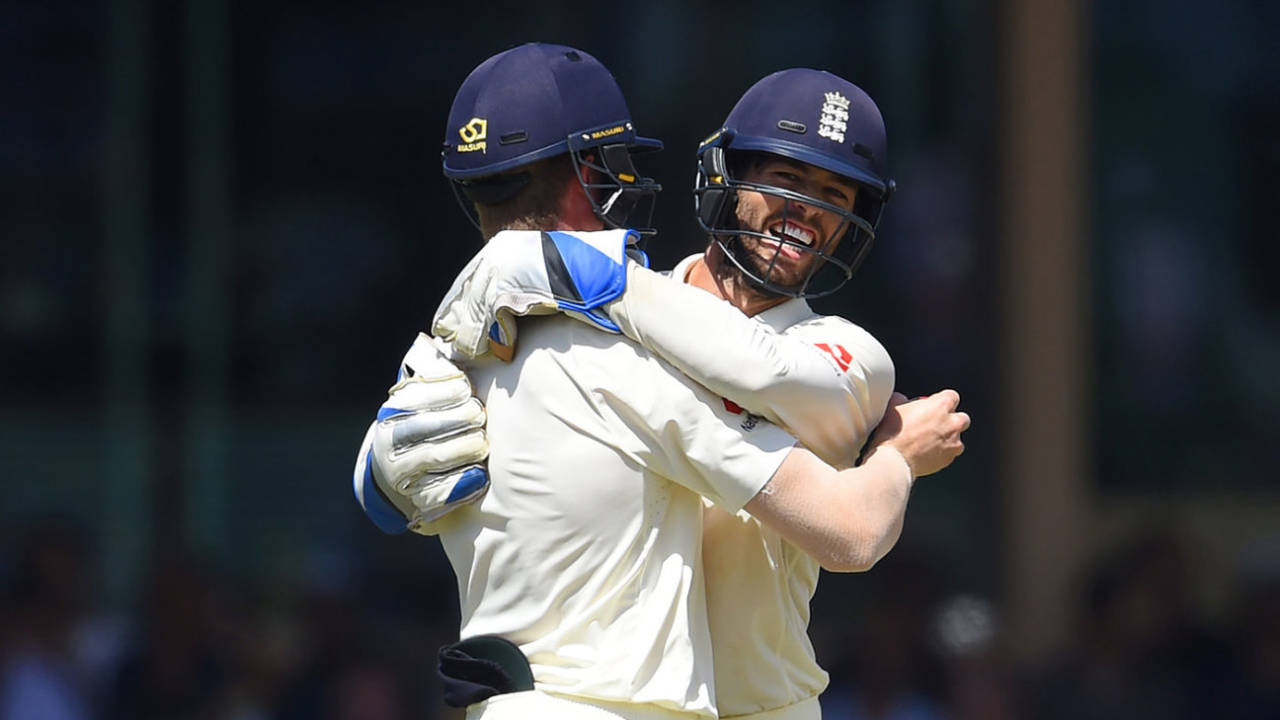Keaton Jennings puts his body on the line once more at short leg
Bravery and anticipation to the fore as England reap the rewards of close attention to close catching
George Dobell in Colombo
24-Nov-2018
Ben Foakes celebrates with Keaton Jennings after another blinder at short leg • AFP
England were once again indebted to an outstanding display at short leg from Keaton Jennings as England battled back from adversity to dominate the second day in Colombo,
For the third time in the space of two Sri Lanka innings, Jennings pulled off an outstanding catch at short leg (to be scrupulously correct, one of the catches in Kandy was taken by the keeper, Ben Foakes, after Jennings parried to ball to him) to conjure a wicket from pretty much nowhere.
He was then back in the action three more times in the innings, combining with Adil Rashid just before tea to remove Dhananjaya de Silva for 73 and break a burgeoning second-wicket stand of 142, before accounting for Dimuth Karunaratne and Roshen Silva after the break, the latter an outstanding sharp one-handed pluck off the face of the bat.
But for innovaton and sheer chutzpah, nothing else on the day compared to his interception take off Danushka Gunathilaka, as he came advancing down the pitch to the left-arm spin of Jack Leach. Skipping along sideways to ensure he stayed alongside the advancing batsman, Jennings spread his arms to make sure he covered as much space as possible and anticipated the possible direction of the ball.
Sure enough, Gunathilaka was only able to get a thick inside edge on the ball which sent it slicing out towards the leg-side. Jennings, no more than two or three metres from the bat, was in position to take the ball on the body and, as he fell backwards to absorb the impact, ensure he was able to clutch on to it.
Fortunate? Maybe a little. Certainly he had to fumble for the ball after it hit him in the midriff. But there's no doubt it is exactly what Jennings intended to do. And he's now done it - or similar - three times over the last Test and a half.
There were several similarities with this dismissal and the two involving Jennings in Kandy. On each occasion, he had successfully anticipated the batsman's movements and the ball's possible direction of travel. In Kandy he moved to his left to block Dimuth Karunaratne's full-blooded sweep (and subsequently parried the ball to Foakes), while he also clung on to a brilliant, if more orthodox, one-handed chance off the inside edge of Dhananjaya de Silva. That wicket of Karunaratne, in particular, was valuable as it came when the batsman was looking solid and England were struggling for a breakthrough.
But the key to Jennings' success in the position is bravery. He appears not to allow thoughts for his own safety to enter his head. So, rather than attempting to take evasive action when he sees the batsman shape for an attacking shot - which is instinctive, up to a point - he instead thinks only about the potential direction the ball will take and tries to put himself in its path. That means he stays low, he keeps his eyes on the batsman - he does not follow the ball's trajectory as it's delivered - and continues to look out for the ball off the bat.
The traditional thinking behind fielding at short-leg was to make yourself into the smallest target possible: to curl up; to protect the head; to get out of the way as soon as your saw the batsman shaping for an aggressive shot. Jennings has gone exactly the opposite way with it. He has made himself as large a target as possible with nothing other than stopping - and hopefully catching - the ball on his mind. His anticipation is impressive, for sure, but without the bravery, he would not be able to put that anticipation into practice.
That bravery shouldn't be taken for granted. He is protected only by a helmet, a box and shin pads, after all. There is a lot more of his body that can be bruised and battered when standing that close. We all know the damage the ball can inflict and, over the last couple of weeks on this tour, we have seen two short-leg fielders injured. One of them (Pathum Nissanka) required a precautionary trip to a hospital; the other was Jennings' opening partner, Rory Burns.
The fact that Burns was one of those fielders may be relevant. In the early days of this tour, Burns looked the better short-leg fielder. But after that blow, the England management decided that Jennings was the better fit for the position, not least because he seemed more keen on it but also because Burns is the more agile ground fielder.
But while Jennings was not a natural in the position, he has worked hard in training with Paul Collingwood and Paul Farbrace. He has concentrated, in particular, on staying low and in position until the very last moment to give himself every opportunity of creating such chances. He has, very quickly, been involved in three memorable catches which have provided a huge boost to his bowlers and his team.
When difficult selections have to be made, in a team so packed with options as England's current Test squad, the ability to make such contributions may well prove valuable for Jennings.
George Dobell is a senior correspondent at ESPNcricinfo
